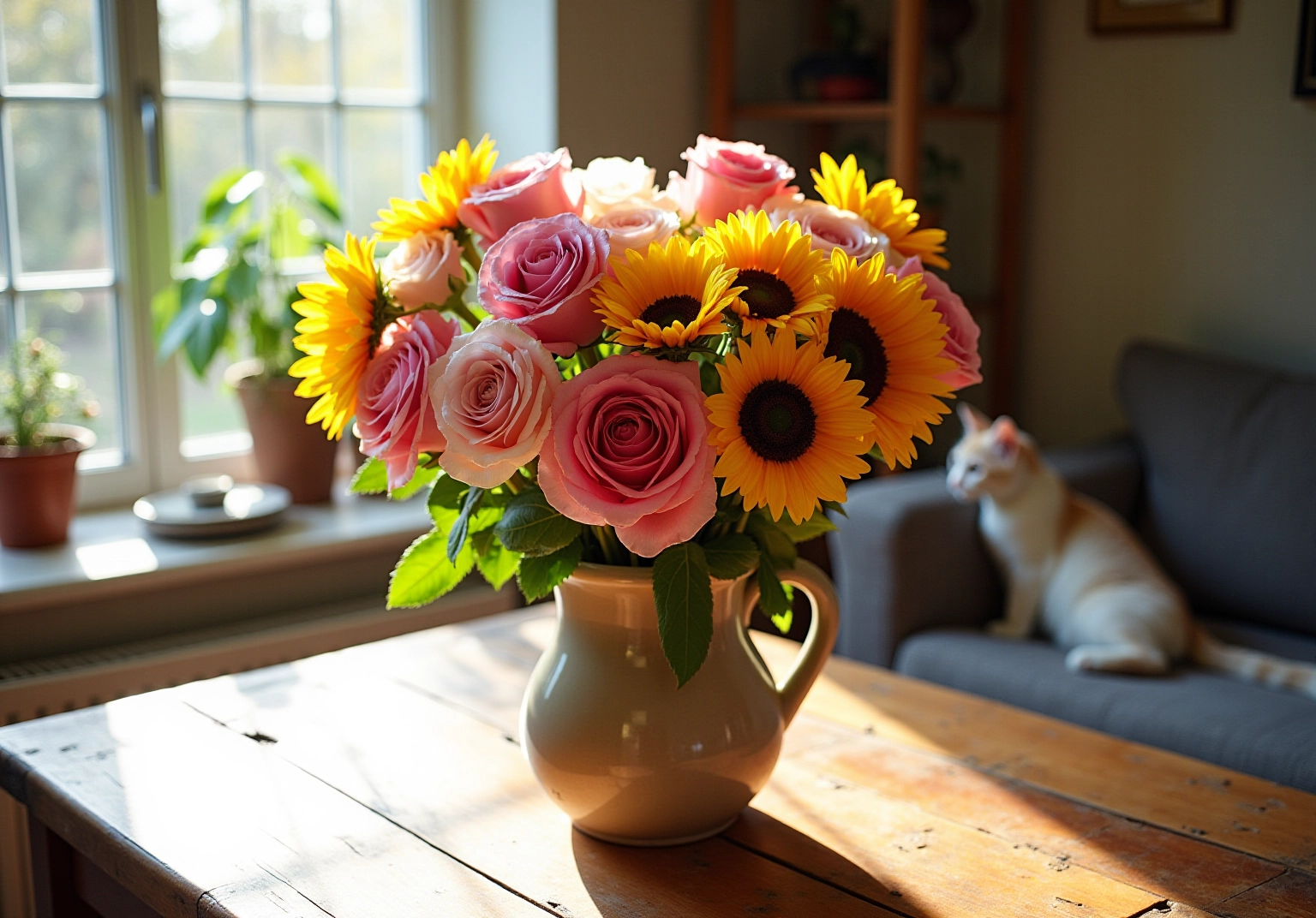
7 Cat Safe Flowers to Brighten Your Home Safely
Overview
For pet owners who cherish their feline companions, choosing cat-safe flowers is not just a matter of home decor; it’s a heartfelt commitment to their pets’ well-being. We understand that the thought of harmful plants can be distressing, and that’s why it’s so important to consider non-toxic options.
Flowers like:
- Roses
- Gerbera daisies
- Orchids
not only add beauty to your living spaces but also provide peace of mind, knowing that your beloved pets are safe from potential health risks. By making informed choices, you can create a harmonious home environment where both your décor and your furry friends can thrive.
Introduction
Creating a harmonious home environment for pet owners often involves navigating the delicate balance between aesthetics and safety. As many flowers pose serious risks to our beloved cats, selecting cat-safe blooms becomes paramount. This article unveils a curated list of seven beautiful, non-toxic flowers that not only brighten our living spaces but also ensure the well-being of our feline companions.
How can we, as pet owners, enjoy the beauty of floral arrangements without compromising our pets’ safety? The answer lies in understanding which flowers are safe and how to thoughtfully incorporate them into our home decor.
Jet Pet Resort: Cat-Safe Flower Arrangements for Your Home
At Jet Pet Resort, we truly understand that creating a beautiful home environment is essential for pet owners. By incorporating cat safe flowers into your plant arrangements, you not only enhance your living space but also prioritize the safety of your beloved feline friends. Choosing the right plants allows you to enjoy the visual benefits of nature while ensuring your cat’s well-being is never compromised. Here are some important considerations for selecting cat-safe flowers that reflect our commitment to pet care:
-
Benefits of Cat-Safe Flowers: Choosing non-toxic flowers significantly reduces the risk of poisoning, allowing your cat to explore and enjoy their surroundings without worry. Flowers that are visually stunning, such as roses, sunflowers, and gerberas, are examples of cat safe flowers for your pets. On the other hand, flowers such as lilies, daffodils, and tulips pose serious risks to felines and can lead to health issues, including gastrointestinal complications and allergic reactions.
-
Significance of Pet-Safe Flora: It is crucial to incorporate pet-safe greenery into your home decor to maintain a harmonious atmosphere. Toxic plants can lead to severe health problems in cats. By selecting secure alternatives, you create a worry-free environment for both you and your furry companions.
Think about arrangements that showcase a variety of cat safe flowers. Bouquets like the Wedding Bells Bouquet, which features cat safe flowers, can brighten your home while keeping your pets safe. Additionally, seasonal selections from local florists can offer a range of safe options. For instance, the ‘My Condolences Bouquet’ includes sunflowers and marigolds, making it a thoughtful choice for grieving cat parents.
-
Pet-Friendly Floral Design Tips: When arranging your floral displays, be sure to keep them out of reach of curious pets to prevent any nibbling. Use sturdy vases and consider incorporating plants like snapdragons and magnolias, which are safe for cats and add a vibrant touch to your decor.
-
Successful Cat-Safe Home Decor Examples: Many pet owners have beautifully integrated cat-safe plants into their homes, creating stunning arrangements that are both lovely and safe. For example, a centerpiece featuring cat safe flowers like orchids and Swedish ivy can serve as an eye-catching focal point while ensuring the safety of your animals. As Dr. Hannah Godfrey notes, ‘Selecting the appropriate plants is crucial for ensuring a secure setting for your pets.’
By thoughtfully choosing cat-friendly blooms and plants, you can enhance your home’s appeal while safeguarding your cherished feline companions.
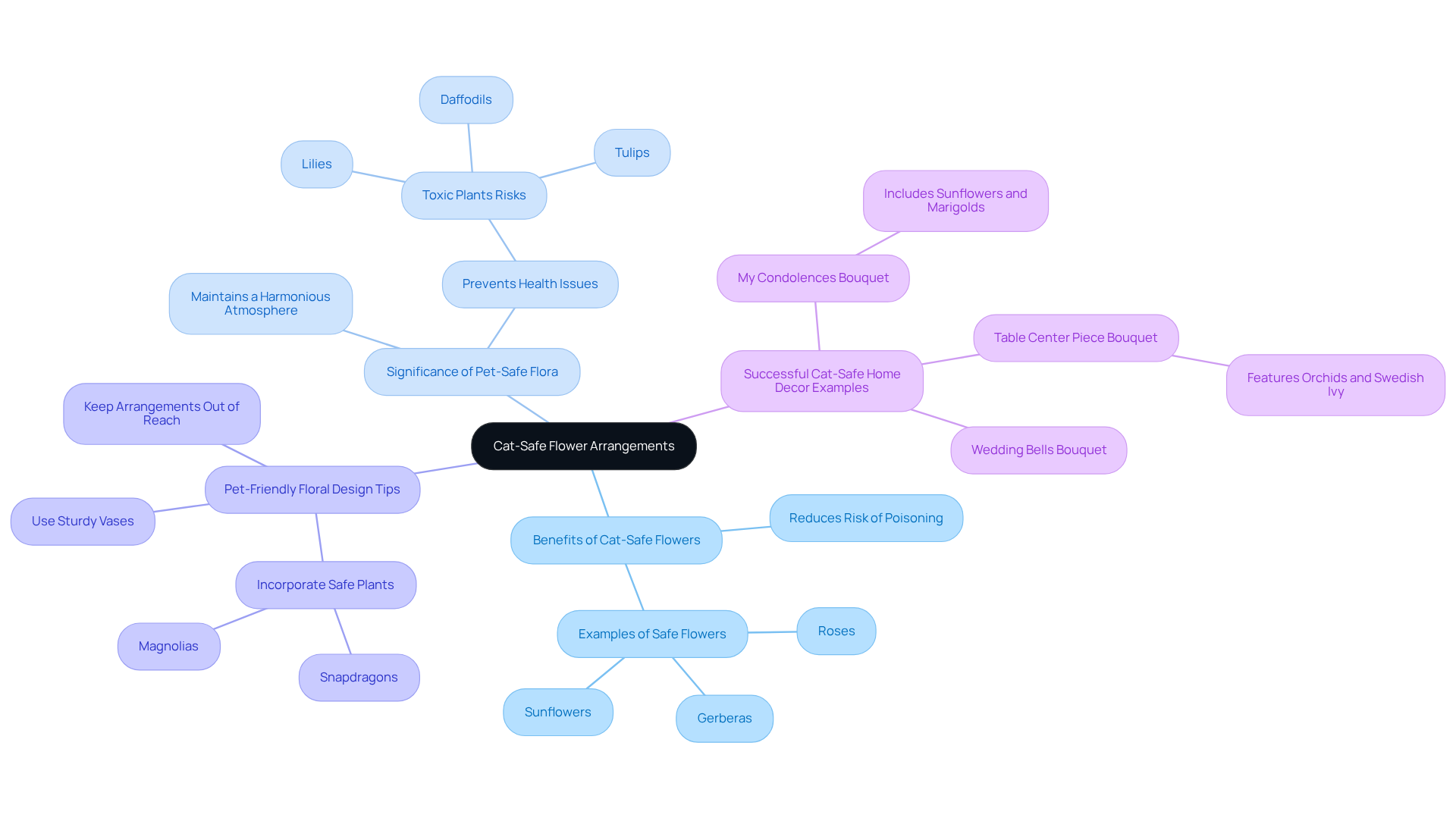
Roses: Are They Safe for Cats?
Roses hold a special place in our hearts as timeless favorites in floral arrangements, yet many pet owners find themselves concerned about whether they are cat safe flowers for our beloved felines. It’s completely understandable to worry about what might harm our furry friends. Fortunately, roses are generally regarded as cat safe flowers, which is a relief for many. However, we must remain vigilant, as consumption can still lead to stomach discomfort. Observing our cats’ behavior around these beautiful plants is essential to ensure their well-being.
Additionally, we must be mindful of the thorns that roses possess, which can pose a significant risk of injury. This is why it’s crucial to position rose arrangements in high, secure vases, well out of reach of curious paws. Taking this precaution not only helps prevent any accidental injuries from playful exploration but also allows us to enjoy the beauty of roses without worry.
While roses themselves do not pose a toxic threat, it’s important to consider potential pesticide exposure, which can lead to gastrointestinal upset if ingested. It’s also worth noting that other plants with ‘rose’ in their name, such as Christmas Rose and Desert Rose, can be toxic to cats. To help satisfy a cat’s natural chewing instincts safely, consider providing cat grass as an alternative.
Overall, with careful placement and consideration, you can choose cat safe flowers like roses to safely brighten your home, allowing you to enjoy their beauty without compromising your cat’s well-being. Remember, nurturing our pets means creating a safe and loving environment for them to thrive.
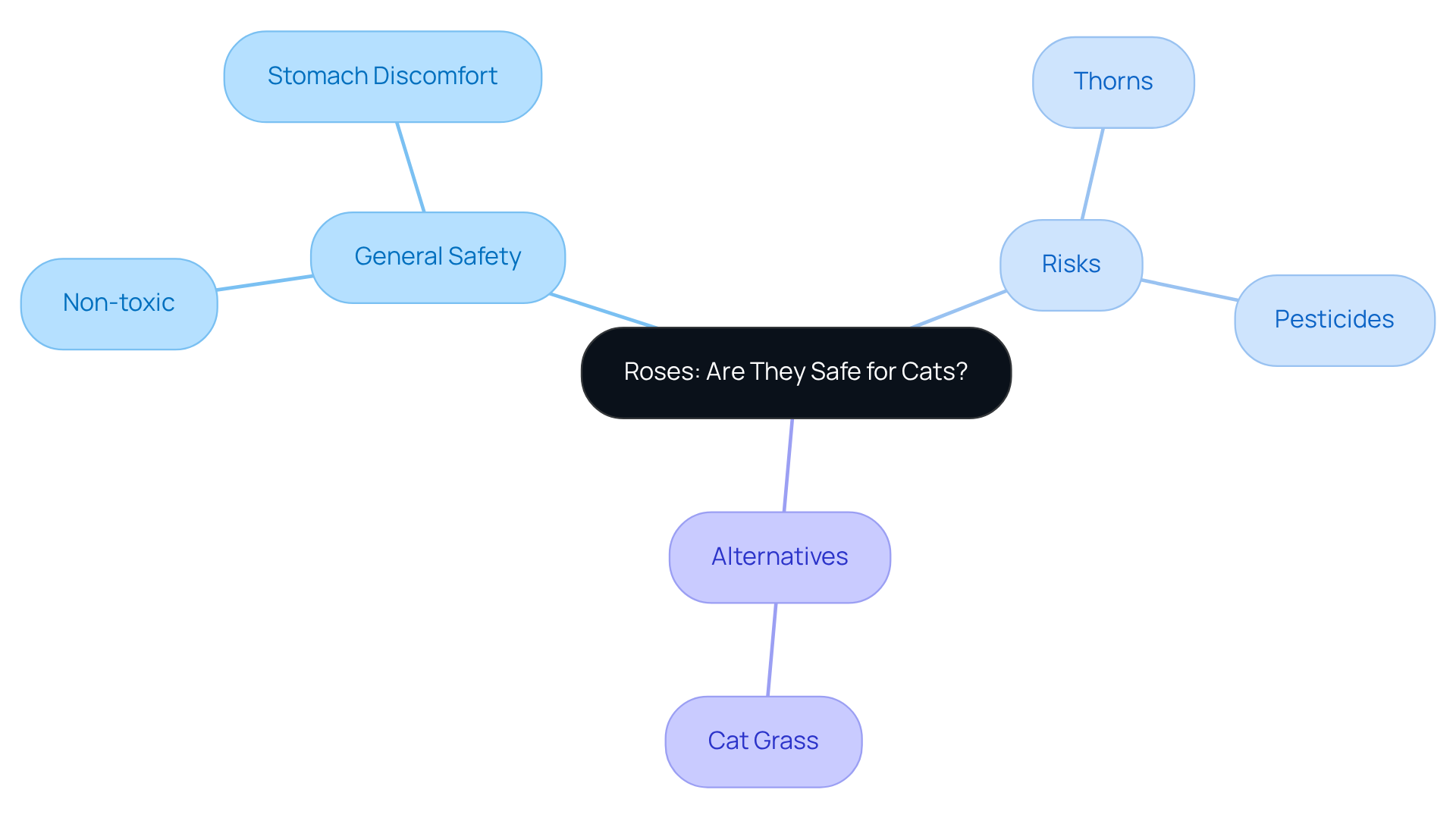
Toxic Flowers: What to Avoid for Your Cats
As a cat owner, being aware of cat safe flowers is essential for ensuring the safety of your beloved pets. Common toxic plants, such as:
- Lilies
- Tulips
- Daffodils
can lead to serious health issues, including gastrointestinal distress and, in extreme cases, organ failure. It’s particularly alarming that every part of lilies is extremely poisonous to felines, and even small amounts can result in kidney damage. As Dominic Carrington poignantly notes, “All parts of lilies, including petals, leaves, pollen, and even water from the vase, are highly poisonous to felines.” Daffodil bulbs, too, contain harmful crystals that can have severe effects on our furry friends if ingested.
To protect your cherished companions, it’s vital to thoroughly investigate any new greenery before welcoming it into your home. Choosing cat safe flowers, such as:
- Petunias
- Zinnias
which are known to be non-toxic, can help you create a vibrant yet secure environment. Testimonials from fellow pet owners emphasize the importance of vigilance in avoiding harmful plants, reinforcing the idea that a proactive approach is crucial for the well-being of our furry family members. Additionally, consulting with a veterinarian about the safety of various plants can further safeguard your pets, ensuring they remain happy and healthy.
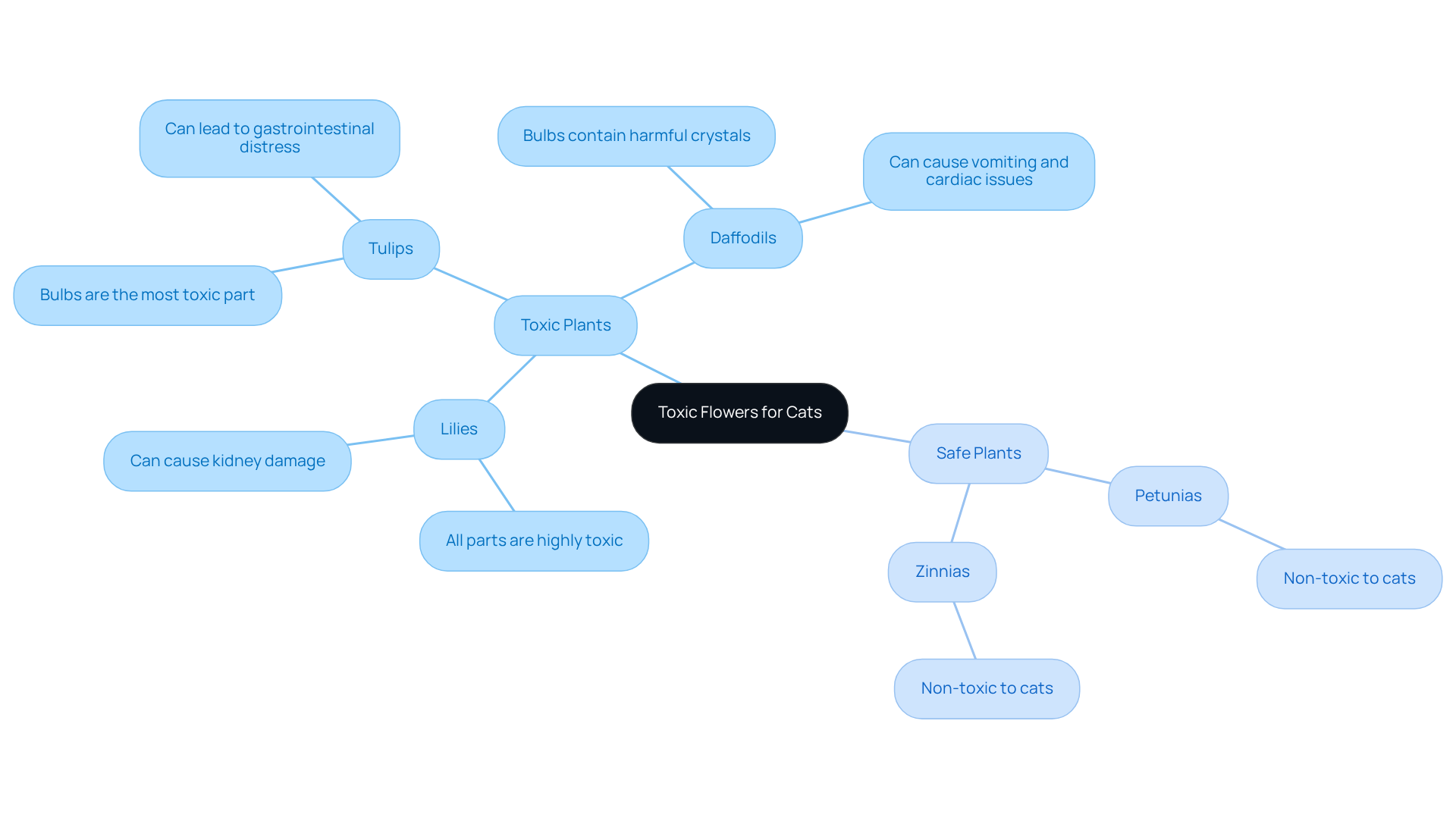
What to Do If Your Cat Eats a Plant
If you suspect your beloved cat has ingested harmful vegetation, it’s crucial to act swiftly. Start by removing any remaining organic material from your cat’s environment to prevent further consumption. Reach out to your veterinarian or an emergency animal poison control hotline without delay for guidance. Be prepared to share specific details about the plants involved and any symptoms your cat may be displaying, such as:
- Vomiting
- Drooling
- Irregular heartbeat
Quick intervention can greatly reduce potential health risks, ensuring that your feline friend receives the care they need as soon as possible. Remember, nearly 10% of calls to the Pet Poison Helpline concern possible cat poisonings, underscoring the importance of acting quickly. As recommended by Lacey vet, understanding the type of vegetation your cat has consumed can help your veterinarian provide the most effective care. In some instances, administering activated charcoal may be suggested, typically at a dose of 1 gram for every pound of body weight, but always consult your veterinarian first to ensure the best course of action.
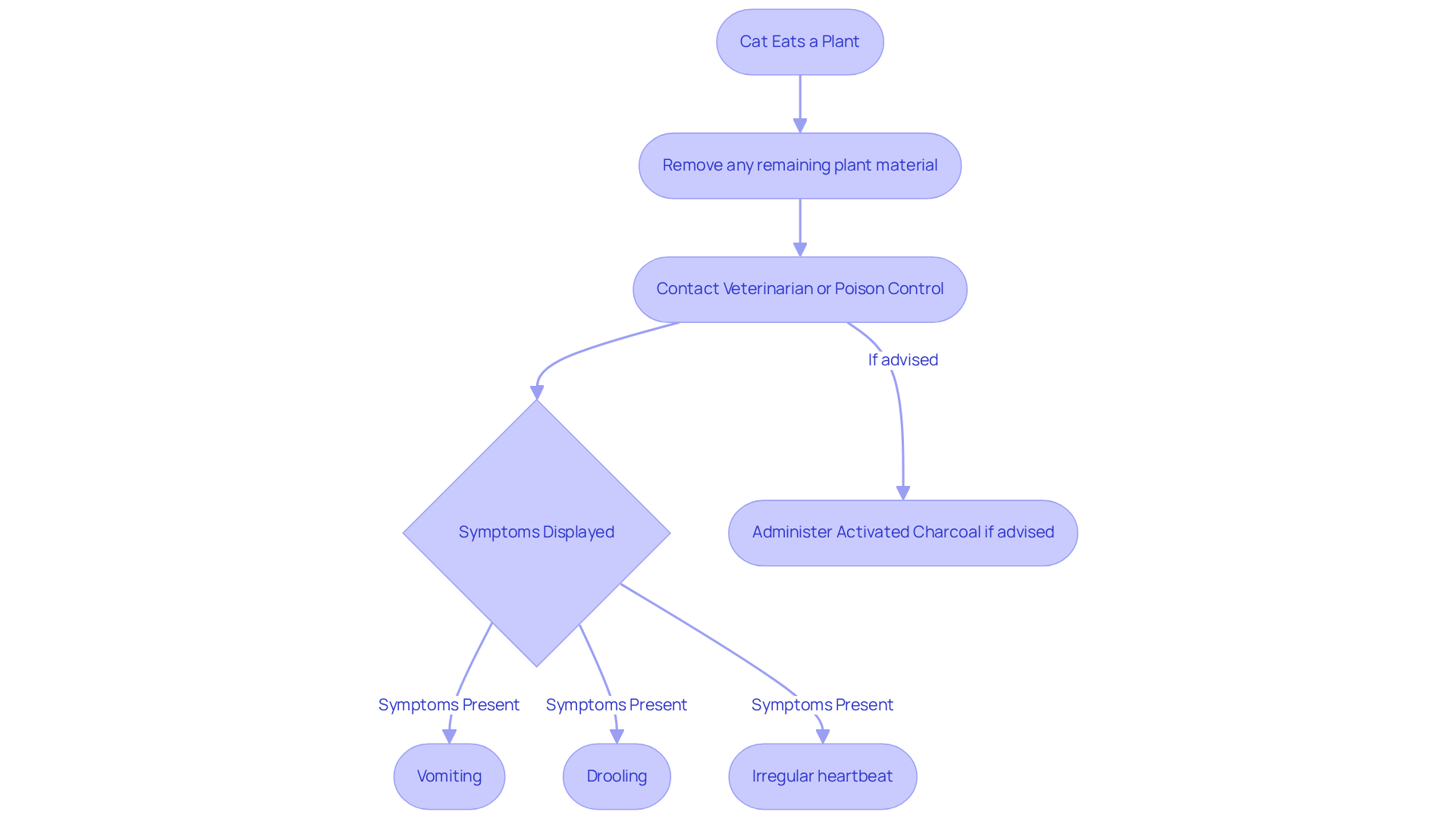
Curious About Cat-Safe Plants? Here’s What You Need to Know
When selecting cat safe flowers that are safe for your beloved cats, it’s crucial to find a balance between aesthetics and safety. You might feel a sense of responsibility to create a beautiful yet secure environment for your furry friends. Consider incorporating plants such as:
- Spider varieties
- Boston ferns
- Money Trees
- Zebra varieties
- Prayer varieties
These choices not only enhance your living space with vibrant greenery but also ensure a nurturing atmosphere for your feline companions.
Spider varieties thrive in bright, indirect light and require moderate watering, while Boston ferns enjoy a humid environment and should be kept damp. Money Trees, often associated with good luck, can grow quickly and typically need bright, indirect light. By investigating the care requirements and compatibility of these species with your home, you can make informed decisions that elevate both your decor and the well-being of your pets.
Selecting cat safe flowers and avoiding harmful types such as lilies and sago palms creates a harmonious environment that enhances your cat’s life while maintaining the beauty of your indoor garden. As Stephanie Rose, a Master Gardener, insightfully notes, “By far one of the easiest species to cultivate, spider varieties have slender leaves that can be green and white striped.”
Additionally, taking a moment to check the ASPCA’s list of toxic and non-toxic plants can provide peace of mind, ensuring a safe haven filled with cat safe flowers for your cherished pets.
Top Cat-Safe Flowers to Brighten Your Home
Consider these top cat-safe flowers to enhance your home while keeping your feline friend safe:
- Roses: These classic blooms are non-toxic to cats, though their thorns require careful handling. Dr. Hannah Godfrey observes, ‘Roses are undeniably one of the best options for cat safe flowers.’
- Gerbera Daisies: These are considered cat safe flowers due to their bright and cheerful appearance, making them completely safe for your pets.
- Orchids: Elegant and non-toxic, making them one of the ideal cat safe flowers that can stunningly enhance any indoor decor. Dr. Hannah Godfrey also mentions that while orchids aren’t harmful to felines, they might cause some indigestion if consumed.
- Sunflowers: Their vibrant colors add a sunny touch to your space, and they are classified as cat safe flowers. Sunflowers are particularly popular in bouquets, which makes them a favorite among pet owners looking for cat safe flowers.
- Zinnias: Known for their colorful and resilient nature, they are perfect for garden arrangements and are considered cat safe flowers for your furry companions.
- Freesias: Stunning aromatic blooms, making them one of the best cat safe flowers.
- Cosmos: Considered cat safe flowers and add a lovely touch to any garden or indoor arrangement.
- Snapdragons: Delightful blooms that are classified as cat safe flowers for your feline friends.
Incorporating cat safe flowers into your home not only enhances your living area but also ensures a secure setting for your cat. Many pet owners value the peace of mind that comes with selecting cat safe flowers, allowing them to enjoy the beauty of plants without the concern of potential harm to their pets. As one pleased customer remarked, ‘Having cat safe flowers in my home allows me to appreciate nature’s beauty without risking my cat’s safety.’ To further ensure your cat’s safety, consider keeping trimmed plants at a reasonable height or using hanging baskets to keep them out of reach. By selecting these options, you can create a vibrant atmosphere while prioritizing your pet’s well-being.
Benefits of Choosing Cat-Safe Flowers for Your Home
Choosing cat safe flowers brings a sense of reassurance to pet owners, addressing a common concern that many of us share. By choosing cat safe flowers like sunflowers, gerbera daisies, and freesias, we can significantly reduce the risk of poisoning and injuries in our furry friends. Just think about it: lilies, while beautiful, are extremely poisonous to cats, and even a small amount can lead to kidney failure. This reality makes the choice of cat safe flowers not just a preference, but an essential aspect of ensuring our pets’ safety.
Integrating cat safe flowers into our homes not only enhances our living spaces but also creates a welcoming environment for both us and our feline companions. As Dr. Hannah Godfrey wisely points out, ‘Sunflowers are non-toxic, which makes them one of the best cat safe flowers for your feline-friendly floral arrangement.’
The presence of cat safe flowers can elevate the visual charm of our homes while ensuring a safe atmosphere, ultimately nurturing a balanced relationship between our love for greenery and the well-being of our animals.
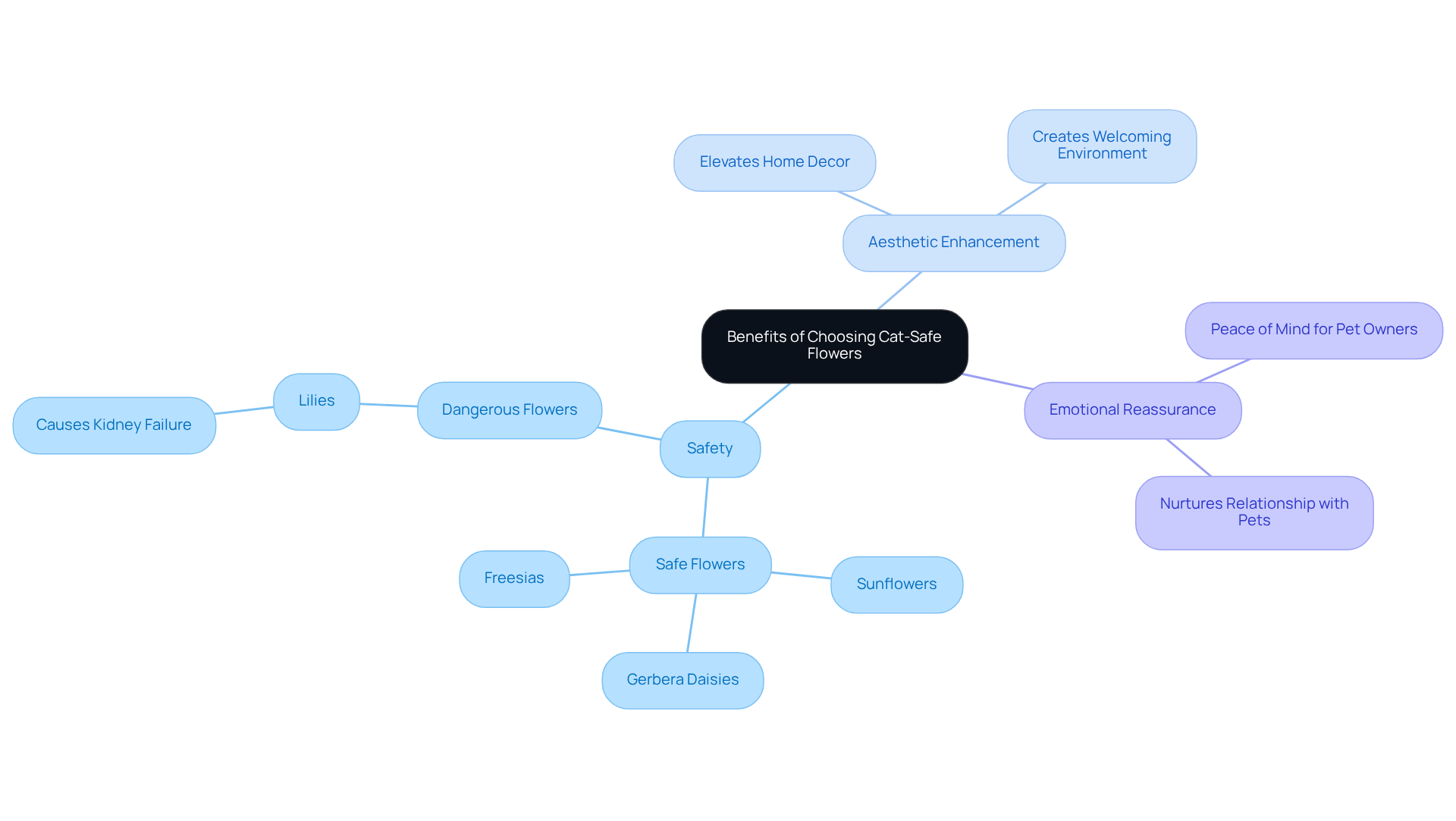
Caring for Cat-Safe Flowers: Tips and Tricks
To ensure your cat-safe flowers thrive while keeping your home a safe haven for your beloved feline friends, it’s important to follow these essential care tips with love and attention:
-
Watering: It’s crucial to maintain proper drainage and avoid overwatering to prevent root rot, which can be harmful to both your plants and your pets. Be cautious, as some plants, like Freesia, can cause mild gastrointestinal upset if ingested. Remember, your cat’s well-being is just as important as your plants’.
-
Light: Arrange your plants according to their specific light needs. For instance, Gerbera daisies flourish in partial or full sun, while Freesia thrives in full sun and fertile, well-draining soil to promote healthy growth. Your plants will thank you for the care you provide.
-
Pruning: Regularly trimming dead leaves and spent blooms not only encourages new growth but also helps maintain the overall health of your plants. Think of it as giving them a gentle refresh, much like the care you give your furry companions.
-
Fertilizing: Opt for pet-safe fertilizers to nourish your plants without putting your cat’s health at risk. It’s a small step that can make a big difference in creating a safe environment for everyone, especially when choosing cat safe flowers.
Furthermore, please be aware that certain plants, such as Lilies, are highly toxic to cats and should be avoided at all costs. By adopting these nurturing methods and thoroughly researching specific plants before bringing them home, you can enjoy vibrant blossoms in your living space while ensuring a secure and loving environment for your cherished pets.
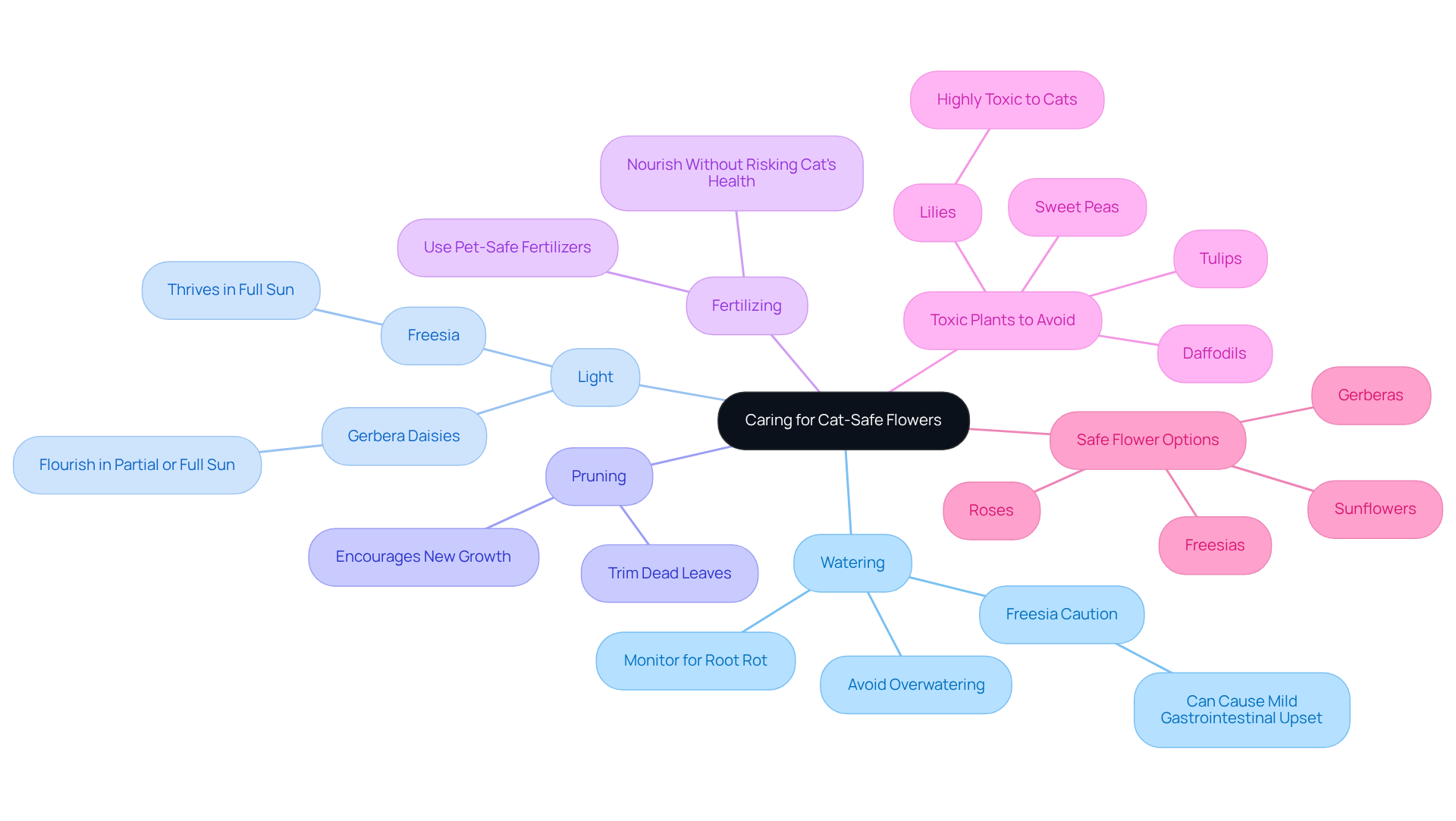
Aesthetic Appeal: Decorating with Cat-Safe Flowers
Transforming your living area with pet-friendly plants can create a vibrant oasis that not only enhances your home’s aesthetic but also nurtures the well-being of your beloved pets. We understand how important it is to ensure that your furry friends are safe while you beautify your surroundings. When crafting arrangements, think about how the colors and textures can harmonize with your existing decor. For instance, using blooms that resonate with your color palette can establish a unified appearance, while thoughtfully positioning arrangements in welcoming spots, such as entryways or dining tables, can draw attention and elevate the atmosphere.
Mixing various heights and textures not only adds visual interest but also ensures that your feline companion remains safe. Pet owners often share heartwarming testimonials about how incorporating these floral elements not only beautifies their homes but also fosters a sense of tranquility and joy. By selecting cat safe flowers, you can fully appreciate the beauty of blooms without compromising your pet’s well-being. It’s crucial to keep all plants out of reach of cats to prevent any potential nibbling, and to ensure that only cat safe flowers are accessible, as many plants can be toxic to them.
Surroundings adorned with blossoms encourage stress relief and emotional healing, transforming your residence into a more tranquil space for both you and your animals. Imagine coming home to a serene environment filled with the gentle beauty of nature, where both you and your pets can thrive together. Let’s create that peaceful sanctuary, ensuring that your home is a safe haven for every member of your family.
Choosing Cat-Safe Flowers: A Smart Decision for Pet Owners
Choosing cat safe flowers is essential for pet owners who want to create a beautiful and secure home for their beloved companions. With over 63% of Australian households sharing their lives with animals, it’s understandable to feel concerned about the safety of your feline friends. Prioritizing their well-being allows you to enjoy the beauty of floral arrangements without the worry of potential dangers.
Thoughtful choices in plant selections not only elevate your living space but also ensure your pets flourish in a safe environment. For instance, flowers like:
- Asters
- Celosia
- Roses
are considered cat safe flowers, while it’s crucial to avoid harmful options such as lilies.
As Mahatma Gandhi wisely stated, “The greatness of a nation and its moral progress can be judged by the way its animals are treated.” By incorporating cat safe flowers into your home decor, you place your pet’s safety at the forefront, fostering a harmonious balance between aesthetics and well-being, and creating a joyful atmosphere for both you and your cherished cats.
To embrace this advice, take the time to research cat safe flowers before making a purchase or decorating, ensuring a safe haven for your furry friends.
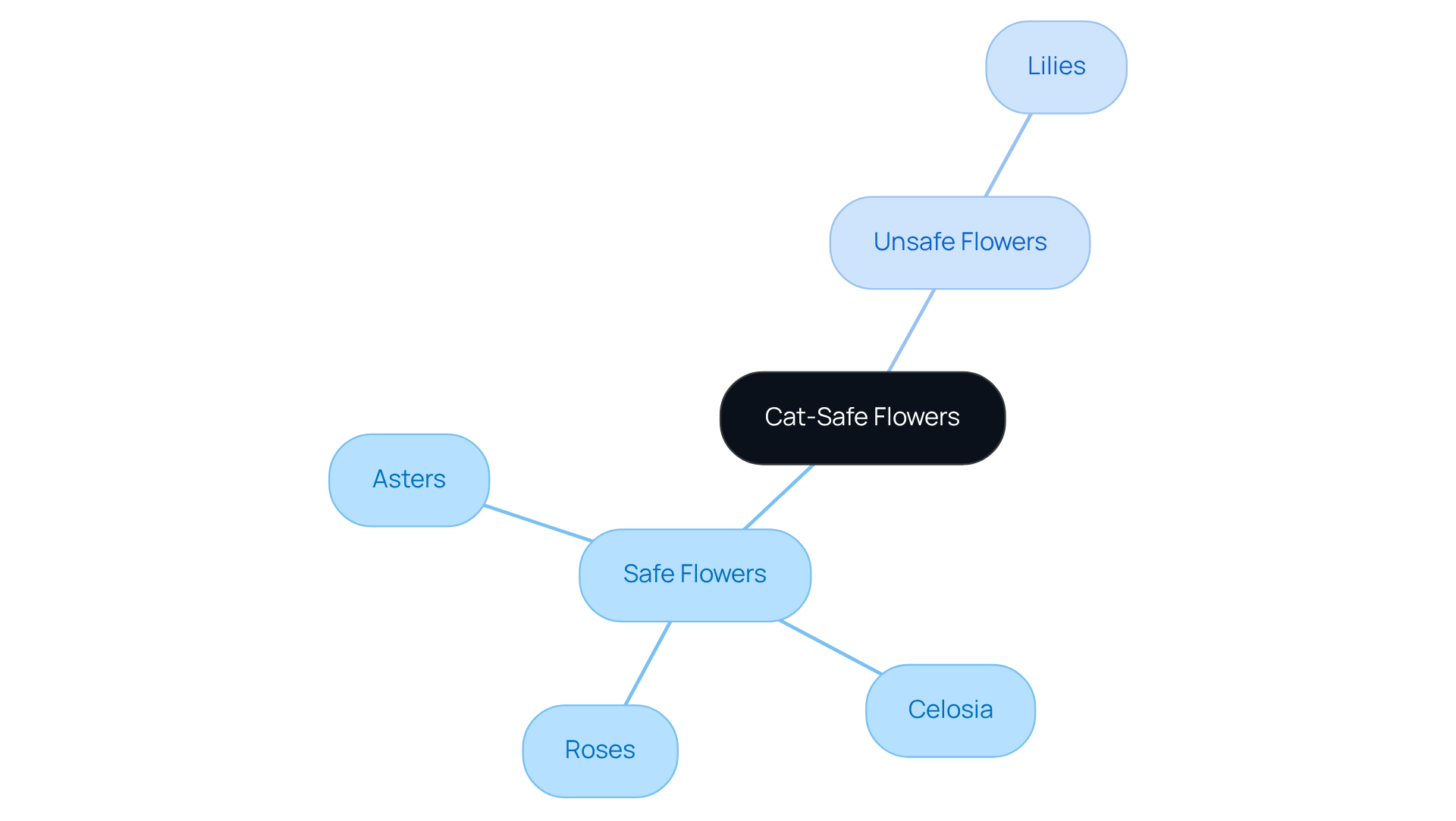
Conclusion
Choosing cat-safe flowers is not merely about aesthetics; it is a crucial step in safeguarding the well-being of our cherished feline companions. By opting for non-toxic flowers, pet owners can cultivate a vibrant and inviting home environment, all while significantly reducing the risk of poisoning or injury to their beloved cats. Flowers such as roses, gerbera daisies, and sunflowers not only beautify living spaces but also instill a sense of security for both pets and their owners.
Throughout this discussion, we emphasize the importance of discerning which flowers are safe for cats and which should be avoided. Toxic plants like lilies and daffodils can pose serious health threats, making informed choices essential for every pet owner. Practical tips for arranging and caring for these plants further underscore the commitment to maintaining a safe home. Additionally, insights from experts highlight the importance of selecting cat-friendly options, fostering a harmonious living space for all.
In closing, the choice to incorporate cat-safe flowers into home decor goes beyond mere aesthetics; it embodies a profound commitment to the safety and well-being of our pets. By prioritizing non-toxic plants, pet owners can nurture an environment that not only celebrates the beauty of nature but also protects their treasured companions. Embracing this approach enhances the home and strengthens the bond between pets and their owners, creating a sanctuary where both can flourish together.
